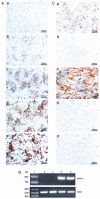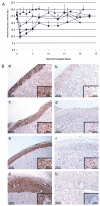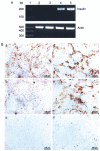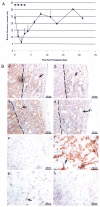Delivery of a therapeutic protein by immune-privileged Sertoli cells
- PMID: 20719072
- PMCID: PMC3087628
- DOI: 10.3727/096368910X516628
Delivery of a therapeutic protein by immune-privileged Sertoli cells
Abstract
Immune-privileged Sertoli cells survive long term after allogeneic or xenogeneic transplantation without the use of immunosuppressive drugs, suggesting they could be used as a vehicle to deliver therapeutic proteins. As a model to test this, we engineered Sertoli cells to transiently produce basal levels of insulin and then examined their ability to lower blood glucose levels after transplantation into diabetic SCID mice. Mouse and porcine Sertoli cells transduced with a recombinant adenoviral vector containing furin-modified human proinsulin cDNA expressed insulin mRNA and secreted insulin protein. Transplantation of 5-20 million insulin-expressing porcine Sertoli cells into diabetic SCID mice significantly decreased blood glucose levels in a dose-dependent manner, with 20 million Sertoli cells decreasing blood glucose levels to 9.8 ± 2.7 mM. Similar results were obtained when 20 million insulin-positive, BALB/c mouse Sertoli cells were transplanted; blood glucose levels dropped to 6.3 ± 2.4 mM and remained significantly lower for 5 days. To our knowledge, this is the first study to demonstrate Sertoli cells can be engineered to produce and secrete a clinically relevant factor that has a therapeutic effect, thus supporting the concept of using immune-privileged Sertoli cells as a potential vehicle for gene therapy.
Figures





Similar articles
-
Sertoli Cells Engineered to Express Insulin to Lower Blood Glucose in Diabetic Mice.DNA Cell Biol. 2018 Aug;37(8):680-690. doi: 10.1089/dna.2017.3937. Epub 2018 Jun 21. DNA Cell Biol. 2018. PMID: 29927618 Free PMC article.
-
Sustained expression of insulin by a genetically engineered sertoli cell line after allotransplantation in diabetic BALB/c mice.Biol Reprod. 2014 May;90(5):109. doi: 10.1095/biolreprod.113.115600. Epub 2014 Apr 2. Biol Reprod. 2014. PMID: 24695630 Free PMC article.
-
Sertoli cell line lacks the immunoprotective properties associated with primary Sertoli cells.Cell Transplant. 2008;17(5):525-34. doi: 10.3727/096368908785096033. Cell Transplant. 2008. PMID: 18714671
-
Immunoprotective sertoli cells: making allogeneic and xenogeneic transplantation feasible.Reproduction. 2010 Mar;139(3):495-504. doi: 10.1530/REP-09-0384. Epub 2009 Dec 8. Reproduction. 2010. PMID: 19995832 Review.
-
Harnessing the immunomodulatory properties of Sertoli cells to enable xenotransplantation in type I diabetes.Immunol Invest. 2003 Nov;32(4):275-97. doi: 10.1081/imm-120025106. Immunol Invest. 2003. PMID: 14603995 Review.
Cited by
-
The battle of the sexes for stroke therapy: female- versus male-derived stem cells.CNS Neurol Disord Drug Targets. 2013 May 1;12(3):405-412. doi: 10.2174/1871527311312030013. CNS Neurol Disord Drug Targets. 2013. PMID: 23469849 Free PMC article. Review.
-
Mouse Sertoli Cells Inhibit Humoral-Based Immunity.Int J Mol Sci. 2022 Oct 23;23(21):12760. doi: 10.3390/ijms232112760. Int J Mol Sci. 2022. PMID: 36361551 Free PMC article.
-
Adult stem cell transplantation: is gender a factor in stemness?Int J Mol Sci. 2014 Aug 28;15(9):15225-43. doi: 10.3390/ijms150915225. Int J Mol Sci. 2014. PMID: 25170809 Free PMC article. Review.
-
The Sertoli cell: one hundred fifty years of beauty and plasticity.Andrology. 2016 Mar;4(2):189-212. doi: 10.1111/andr.12165. Epub 2016 Feb 4. Andrology. 2016. PMID: 26846984 Free PMC article. Review.
-
Sertoli Cells Loaded with Doxorubicin in Lipid Micelles Reduced Tumor Burden and Dox-Induced Toxicity.Cell Transplant. 2017 Oct;26(10):1694-1702. doi: 10.1177/0963689717721223. Cell Transplant. 2017. PMID: 29251108 Free PMC article.
References
-
- Barry SC, Ramesh N, Lejnieks D, Simonson WT, Kemper L, Lernmark A, Osborne WR. Glucose-regulated insulin expression in diabetic rats. Hum. Gene Ther. 2001;12(2):131–139. - PubMed
-
- Bellgrau D, Gold D, Selawry H, Moore J, Franzusoff A, Duke RC. A role for CD95 ligand in preventing graft rejection. Nature. 1995;377(6550):630–632. - PubMed
-
- Davidson HW. (Pro)Insulin processing: A historical perspective. Cell Biochem. Biophys. 2004;40(3 Suppl.):143–158. - PubMed
-
- Dong H, Altomonte J, Morral N, Meseck M, Thung SN, Woo SL. Basal insulin gene expression significantly improves conventional insulin therapy in type 1 diabetic rats. Diabetes. 2002;51(1):130–138. - PubMed
-
- Dufour JM, Dass B, Halley KR, Korbutt GS, Dixon DE, Rajotte RV. Sertoli cell line lacks the immunoprotective properties associated with primary Sertoli cells. Cell Transplant. 2008;17(5):525–534. - PubMed
Publication types
MeSH terms
Substances
Grants and funding
LinkOut - more resources
Full Text Sources
Medical
Research Materials

